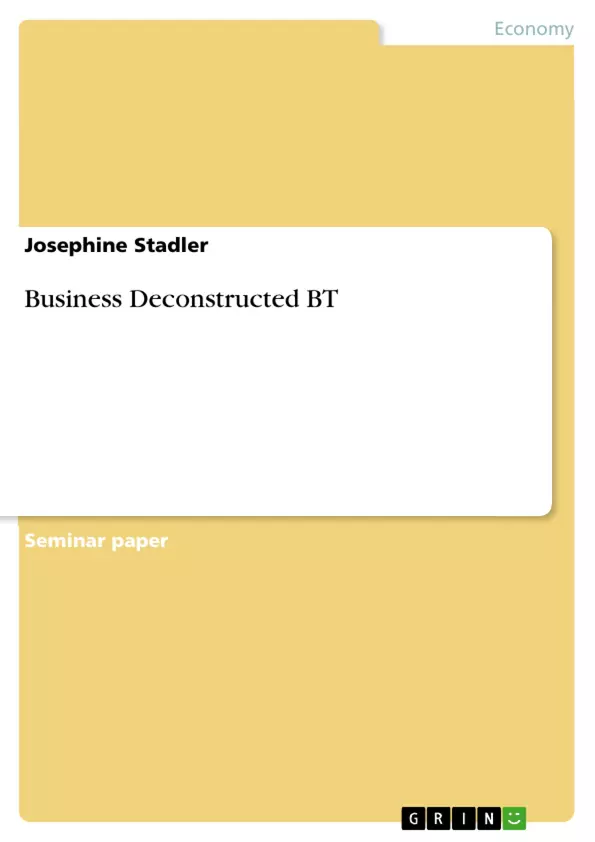BT Group plc is a provider of telecommunications employing a total of 100,000
people worldwide and operating in 170 countries. In the UK, BT serves more than 20 million business and residential customers. The group consists of the following 5 sectors: (Company Profile, 2006). BT’s vision is to be dedicated to helping customers thrive in a changing world (Vision, 2006). A vision in general is the “desired future state: the aspiration of the organisation”, whereas a mission is the “overriding purpose in line with the values
or expectations of stakeholders” (Johnson & Scholes, 2005, p. 13). BT’s mission is “to be the leader in delivering converged networked services”. (Annual Report, 2006, p. 7) [...]
Table of Contents
- Introduction
- Company profile
- BT's vision and mission
- Stakeholder Theory
- BT's stakeholder definition
- Addressee of this report
- Stakeholder mapping – the needs of shareholders
- BT's legal form and its implication on shareholders
- Memorandum of Association
- Shares
- Dividends
- AGM
- Analysis of the financial strengths and weaknesses
- Accounting records
- Horizontal Analysis
- Profit margin
- Profitability - roce
- Efficiency - asset turnover
- Liquidity current ratio & quick ratio test
- Structure - leverage ratio & debt to shareholders' equity
- Cash Flow
- Comparison of BT to the Deutsche Telekom
- BT's financial strengths and weaknesses
- New financial strategy
- BT's overall strategy
- BT's new financial strategy
- Implementation of the new financial strategy
- Inform shareholders
- Build a team
- Introduce Balanced Scorecard
- Proposed Balanced Scorecard Approach
- Budgeting
- Proposed Budgeting Process
Objectives and Key Themes
The main objective of this report is to analyze the financial strengths and weaknesses of BT Group plc. The report aims to evaluate how the organization's legal form impacts its interactions with stakeholders and proposes a new financial strategy that addresses identified issues while satisfying the needs of various stakeholders.
- Stakeholder Theory and its application to BT Group plc
- The legal form of BT Group plc and its implications for shareholders
- Financial analysis of BT Group plc, including strengths and weaknesses
- Development of a new financial strategy for BT Group plc
- Implementation of the new financial strategy through internal processes and structures
Chapter Summaries
The report begins by introducing BT Group plc, providing information on its company profile, vision, and mission. The subsequent chapters delve into stakeholder theory and its application to BT, specifically exploring how BT defines its stakeholders and how the organization interacts with them. The report then analyzes BT's legal form as a public limited company, examining its impact on shareholder rights and responsibilities.
Following this, the report conducts a comprehensive financial analysis of BT Group plc, highlighting the organization's strengths and weaknesses. The analysis utilizes various financial ratios and metrics to evaluate profitability, liquidity, efficiency, and financial structure. This analysis is further contextualized through a comparison of BT to its competitor, Deutsche Telekom.
The report culminates in the development and proposal of a new financial strategy for BT Group plc. This strategy aims to address the identified financial weaknesses and achieve the organization's strategic goals while considering the needs of all stakeholders. The report concludes by outlining the internal processes and structures required to implement the new financial strategy, including communication with shareholders, team building, and the introduction of a balanced scorecard.
Keywords
The primary keywords and focus topics of the report include stakeholder theory, legal form of a company, financial analysis, profitability, liquidity, efficiency, financial structure, new financial strategy, implementation, balanced scorecard, budgeting, and stakeholder engagement. The report focuses on examining the relationship between BT Group plc's legal form and its interactions with stakeholders, analyzing its financial performance, and proposing strategies for future growth and success.
- Quote paper
- BA (Hons) Business Management and Administration Josephine Stadler (Author), 2007, Business Deconstructed BT, Munich, GRIN Verlag, https://www.grin.com/document/67530



